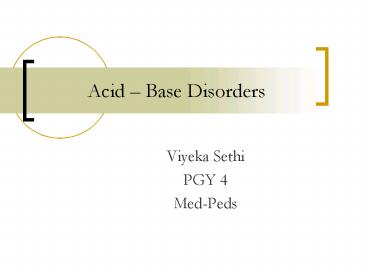Acid Base Disorders - PowerPoint PPT Presentation
1 / 16
Title: Acid Base Disorders
1
Acid Base Disorders
- Viyeka Sethi
- PGY 4
- Med-Peds
2
Four Main Acid-Base Disorders
3
Normal Values
4
Step by Step
- Determine the primary disturbance
- Acidemia or Alkalemia look at the pH
- lt 7.40 acidemia
- gt 7.40 alkalemia
- Respiratory or Metabolic look at HCO3 and CO2
- HCO3 primary metabolic acidosis
- pCO2 primary respiratory acidosis
- and vice versa for alkalosis
5
- Determine acute or chronic for Respiratory
Disturbance - Compensation attempts to normalize pH but can be
present with an abnormal pH - Expected change in pCO2 best used for primary
metabolic disturbance and expected change in HCO3
for primary respiratory disturbance
6
Respiratory Disturbance Compensation
7
- Primary Metabolic Disturbance
- Calculate anion gap Na (Cl HCO3)
- Normal 12 /- 2
- If gap is gt20 then there is primary metabolic
acidosis regardless of pH or bicarb. - Helps narrow differential with a anion gap or
non-anion gap metabolic acidosis
8
- Assess appropriate respiratory compensation for
metabolic disorder - Respiratory compensation is fast
- Winters formula
- Expected pCO2 (1.5 HCO3) 8 (/-2)
- If measured pCO2 is
- lt expected then co-existing resp. alkalosis
- gt expected then co-existing resp. acidosis
9
- Determine if other metabolic disturbances
co-exist with AG metabolic acidosis - Delta gap accounts for increase in anion gap
and shows any variation in HCO3 - If no other disorder is present then the
calculation should be 24
10
Delta Gap
- Corrected HCO3 measured HCO3 (AG - 12)
- So if corrected HCO3
- gt24 then metabolic alkalosis co-exists
- lt24 then non-anion gap metabolic acidosis
co-exists
11
Hints
- Simple acid base compensatory response always
in direction of primary variable - Compensation is more pronounced with chronic
disorders - Normal pH indicates two or more acid-base
disorders - If given electrolytes, use them!!!
12
Pneumonics for pnuemonic lovers
13
Case 1
- 3 yo boy with diarrhea is evaluated in the ER.
Initial ABG shows - ph 7.23
- HCO3 10
- pCO2 23
- AG - 13
Expected pCO2 (1.5 HCO3) 8
/-2 So, Expected pCO2 (1.5 10) 8
/-2 (15) 8 /-2 23 /- 2 So, we have a
metabolic acidosis with respiratory compensation
Alkalemia or acidemia? Low pH acidemia
Primary disturbance resp. or metabolic? Low HCO3
metabolic acidosis
Normal AG so no need for Delta gap
equation BUT Is there adequate respiratory
compensation? (Use Winters formula)
14
Case 2
- 5 yo boy presents to ED with dyspnea for 3 days.
ABG shows the following - pH 7.35
- paCO2 60
- paO2 57
- HCO3 - 31
Acidemia or alkalemia? Low pH Acidemia
Primary Resp. or Metabolic disturbance? Respirator
y
Check yourself.using rules for Primary Resp
disturbance For every 10 increase in pCO2 - pH
decreases by .08 acutely or .03 chronically HCO3
increases by 1 acutely or 3 chronically So, this
is a chronic resp. acidosis
15
Case 3
- 15 yo with 4 days of vomiting and fever.
- pH- 7.50 Na- 138
- pCO2- 42 Cl- 80
- pO2- 80 HCO3- 34
Acidemia or alkalemia? High ph alkalemia
Respiratory or Metabolic? High HCO3 metabolic
Anion Gap? 138 (80 34) 24
Is Resp. compensation appropriate? Exp. pCO2
(1.5 HCO3) 8 /-2 (51) 8 /-2 59 /-
2 So, NO the CO2 is lower so we have a
Co-existent resp.alkalosis
Checking the Delta gap only useful in a primary
metabolic acidosis.
16
Case 4































